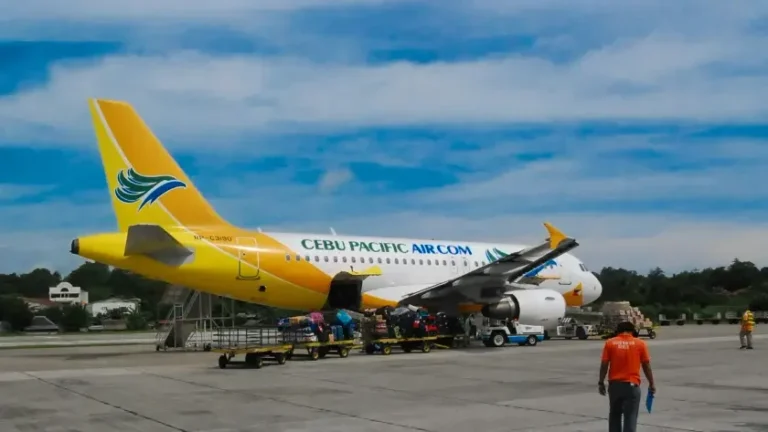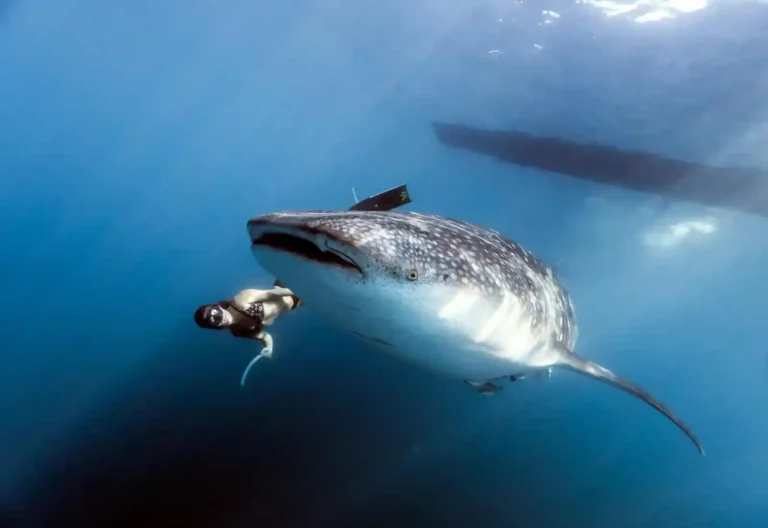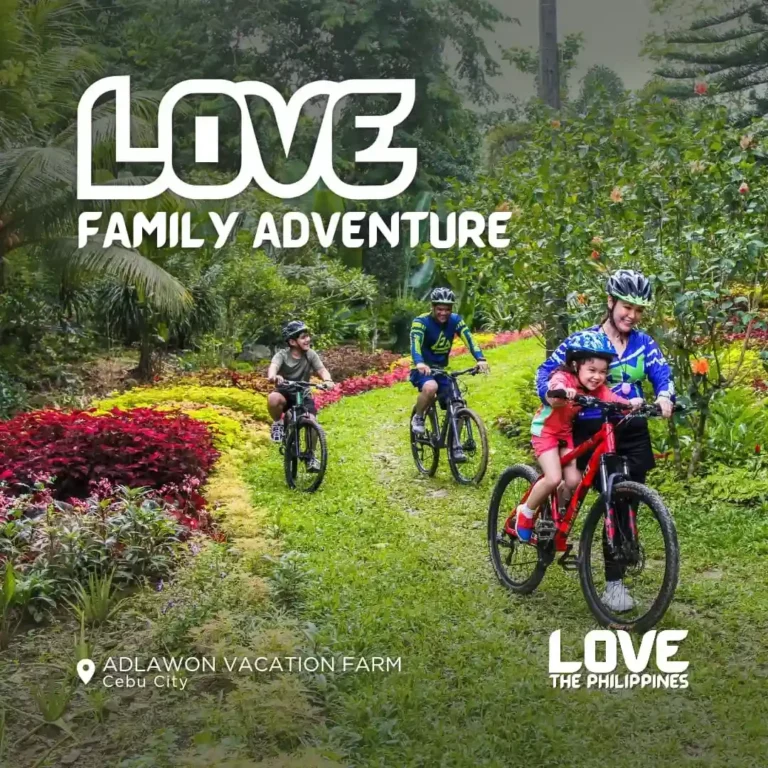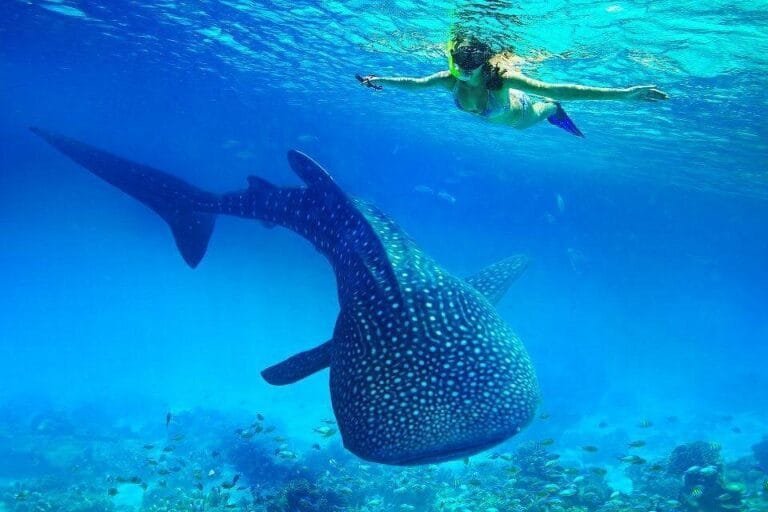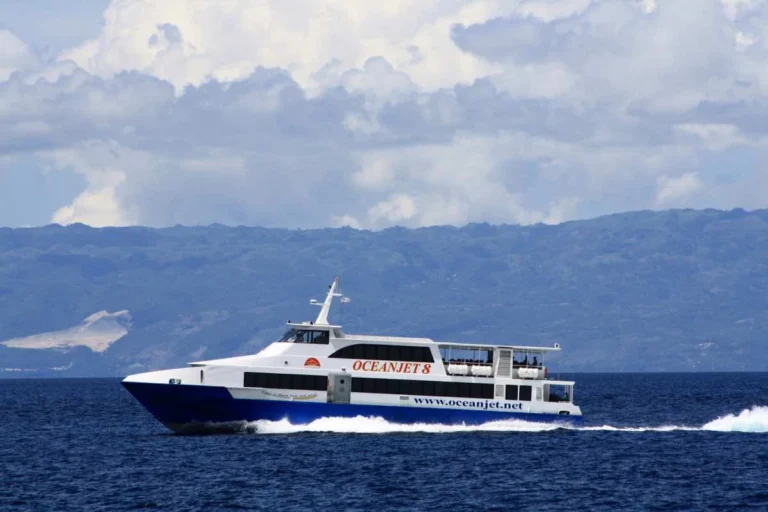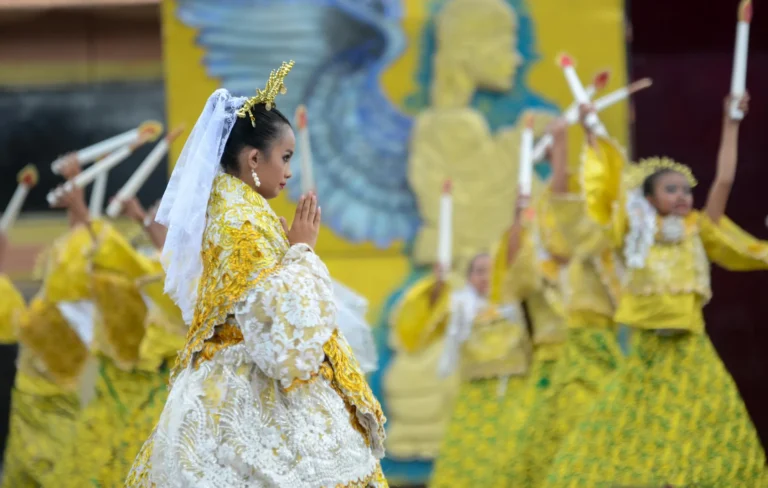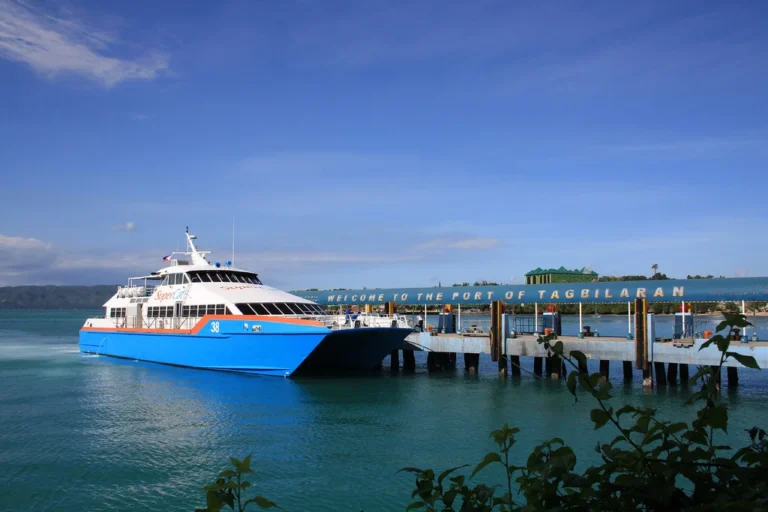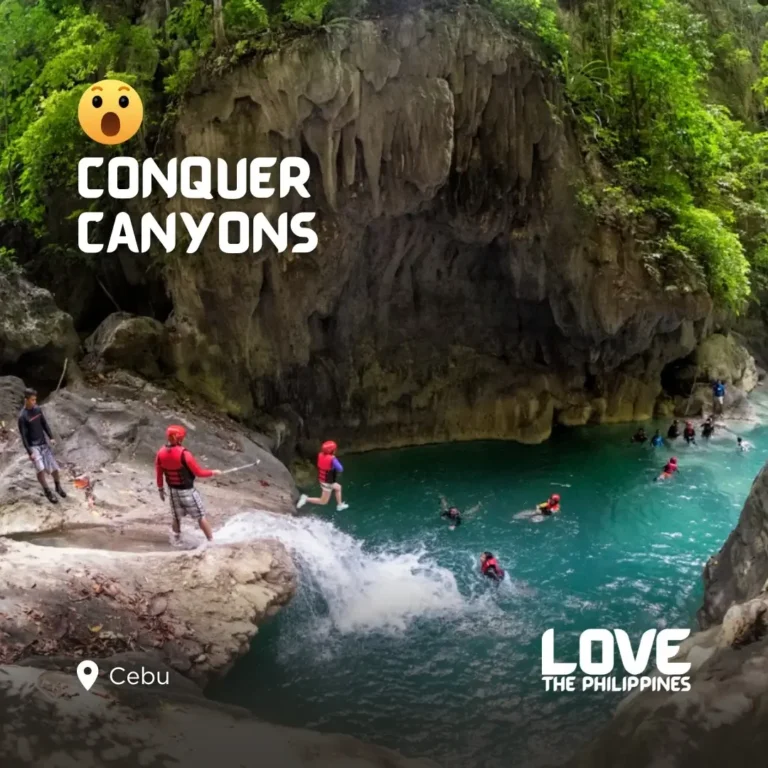Welcome to Moalboal, the adrenaline capital of South Cebu and your gateway to the Philippines’ most incredible natural phenomena. This coastal town has transformed from a quiet fishing village into Southeast Asia’s premier adventure destination, where millions of sardines dance in synchronized schools just meters from shore while world-class waterfalls offer heart-pounding canyoneering adventures. With over 12 million sardines creating mesmerizing underwater tornadoes, three levels of Kawasan Falls canyoneering from beginner to extreme, and strategic positioning as South Cebu’s transport hub, Moalboal offers the perfect blend of marine wonders and terrestrial thrills. Whether you’re here for gentle snorkeling with sardines or cliff-jumping into turquoise pools, this comprehensive guide covers every detail you need to maximize your South Cebu adventure.
The Legendary Moalboal Sardine Run – Complete Timing & Strategy Guide
The Moalboal sardine run isn’t just another snorkeling activity—it’s witnessing one of nature’s most spectacular phenomena where 10-15 million sardines create massive underwater tornadoes visible from the surface. Understanding the precise timing, seasonal patterns, and optimal viewing strategies transforms a good experience into an unforgettable encounter.
Best of Cebu Attractions
Hour-by-Hour Sardine Activity Patterns
6:00-7:00 AM – Prime Time Magic
- Sardine behavior: Massive schools in shallow water (3-8 meters)
- Why optimal: Sardines feed on plankton most actively at dawn
- Water conditions: Calmest seas, best visibility (15-20 meters)
- Crowd levels: Virtually empty – you’ll have sardines to yourself
- Turtle bonus: 80% chance of green sea turtle encounters
- Photography: Perfect lighting conditions for underwater shots
7:00-9:00 AM – Excellent Conditions
- Sardine behavior: Still dense schools, slightly deeper (5-12 meters)
- Activity level: High sardine movement and feeding behavior
- Water conditions: Calm, good visibility (12-18 meters)
- Crowd levels: Few early tourists arriving
- Success rate: 95%+ for impressive encounters
9:00 AM-12:00 PM – Good Tourist Hours
- Sardine behavior: Schools more dispersed, deeper positioning
- Activity level: Moderate movement, less dramatic formations
- Water conditions: Slight chop developing, reduced visibility
- Crowd levels: Moderate tourist presence
- Success rate: 85-90% for solid encounters
12:00 PM-3:00 PM – Midday Decent
- Sardine behavior: Scattered schools, seeking shade/deeper water
- Activity level: Reduced feeding, more defensive positioning
- Water conditions: Choppy surface, 8-12 meter visibility
- Crowd levels: Peak tourist hours, crowded waters
- Success rate: 70-80%, less dramatic displays
3:00-6:00 PM – Afternoon Recovery
- Sardine behavior: Schools reforming for evening feeding
- Activity level: Increasing movement as temperatures cool
- Water conditions: Calming seas, improving visibility
- Crowd levels: Moderate, many tourists leaving
- Success rate: 80-85%, good for second attempts
6:00 PM+ – Evening & Night
- Sardine behavior: Different species active, smaller schools
- Night diving available: Specialized tours with underwater lights
- Conditions: Advanced snorkelers/divers only
- Special sightings: Bioluminescent plankton during new moon
Seasonal Sardine Movement Patterns
Peak Season (December-May) – Maximum Density
- Location: Primarily off Panagsama Beach, 20-50 meters from shore
- School size: 10-15 million individuals in mega-schools
- Behavior: Tight formations, dramatic tornado effects
- Visibility: 15-25 meters on calm days
- Best months: February-April for most spectacular displays
Transition Period (June & November) – Variable
- Location: Schools may move between Panagsama and White Beach areas
- School size: 8-12 million, more fragmented groups
- Behavior: Less predictable movements, still impressive
- Visibility: 10-18 meters depending on weather
- Advantage: Fewer tourists, more intimate encounters
Monsoon Season (July-October) – Weather Dependent
- Location: Sardines seek calmer waters, closer to shore during storms
- School size: 6-10 million, tighter defensive formations
- Behavior: More reactive to weather, deeper positioning
- Visibility: 8-15 meters, highly variable
- Strategy: Multiple attempts recommended, weather watching essential
Advanced Sardine Encounter Techniques
Snorkeling Strategy for Maximum Impact:
- Entry point: Chili Bar area, swim straight out 30-50 meters
- Swimming technique: Slow, deliberate movements – sudden motions disperse schools
- Breath-holding: 30-60 second breath holds allow closer approach
- Photography positioning: Swim to school edges, shoot toward center mass
- Respectful distance: 2-3 meters minimum to avoid disrupting feeding
Free-diving Enhancement:
- Depth capability: Schools extend 5-15 meters deep – diving skills access best views
- Buoyancy control: Perfect neutral buoyancy prevents school dispersal
- Camera techniques: Strobes/video lights reveal true colors at depth
- Safety protocols: Always dive with buddy, practice proper techniques
Professional Photography Tips:
- Equipment: Wide-angle lens essential, GoPro sufficient for beginners
- Settings: Manual mode, ISO 400-800, fast shutter for movement
- Composition: Include divers/snorkelers for scale, capture tornado formations
- Timing: Shoot during 6-8 AM golden hour for dramatic backlighting
🐠 Experience the Ultimate Sardine Run ✅ 15+ million sardines in synchronized schools 🌅 6:00 AM encounters with 95% fewer tourists
🐢 80% turtle encounter rate during early morning visits 📸 Professional underwater photography guidance available ⏰ Peak season schools largest Feb-April! 👉 [Book Dawn Sardine Experience] | [Photography Tour Package] – Witness nature’s greatest underwater spectacle!
Kawasan Falls Canyoneering – Complete Adventure Breakdown
Kawasan Falls canyoneering has evolved from a local adventure into one of Southeast Asia’s premier water sports experiences, offering three distinct difficulty levels that cater from cautious beginners to adrenaline junkies. Understanding each stage, safety requirements, and seasonal considerations ensures you choose the perfect adventure level while maximizing safety and enjoyment.
The Complete Canyoneering Route System
Starting Point: Sirao Flower Garden Area
- Elevation: 400 meters above sea level
- Journey begins: Traditional habal-habal ride through mountain villages
- Duration to start: 45 minutes from Moalboal town center
- Briefing location: Safety equipment fitting and instruction
Level 1: Beginner Adventure (2-3 hours)
Perfect for: First-time canyoneers, families with teens 12+, those wanting beautiful scenery without extreme challenges
Route Overview:
- Total distance: 3 kilometers of river trekking
- Elevation drop: 200 meters gradual descent
- Jump heights: 3-8 meters (all optional with walk-around routes)
- Swimming sections: 6 natural pools with calm currents
- Technical skills: Basic swimming, following guide instructions
Key Highlights & Challenges:
- Jump 1: 3-meter practice jump into deep pool
- Bamboo slide: Natural 15-meter slide through smooth rock channel
- Swimming section: 100-meter swim through turquoise canyon pools
- Jump 2: 6-meter jump (can walk around if preferred)
- River trekking: Rock hopping and shallow water walking
- Final approach: Easy descent to Kawasan Falls main pool
Safety Equipment Provided:
- Life jacket: Mandatory for all participants
- Helmet: Protection from rock falls and impacts
- Aqua shoes: Grip for slippery rocks and protection from sharp edges
- Dry bag: Small waterproof container for phone/valuables
Level 2: Intermediate Thrill (3-4 hours)
Perfect for: Confident swimmers, adventure seekers, those wanting more challenging jumps
Additional Route Elements:
- Total distance: 4.5 kilometers including technical sections
- Jump heights: 5-15 meters with mandatory participation
- Technical climbing: Rock scrambling and rope-assisted sections
- Advanced swimming: Stronger currents, longer swim sections
- Cliff walking: Narrow ledges requiring balance and confidence
Signature Challenges:
- The Slide Complex: Series of 3 natural slides with 90-degree turns
- Cathedral Jump: 12-meter leap from cave-like rock formation
- Technical swim: 200-meter swim through narrow canyon passage
- Rope climb: 8-meter ascent using fixed ropes and footholds
- Final jump series: Choice of 8-meter or 15-meter final jump
Enhanced Equipment:
- Upgraded life jacket: More buoyant for stronger currents
- Climbing harness: Safety line attachment for technical sections
- Specialized footwear: Better grip for advanced rock sections
Level 3: Extreme Adventure (4-6 hours)
Perfect for: Experienced adventure athletes, confident cliff jumpers, those seeking maximum adrenaline
Advanced Route Extensions:
- Total distance: 6+ kilometers including remote canyon sections
- Jump heights: 10-25 meters (some mandatory)
- Technical difficulty: Rock climbing, rappelling, advanced swimming
- Physical demands: High fitness level required
- Group size: Maximum 6 people for safety
Extreme Challenge Highlights:
- The Monster Jump: 25-meter cliff jump (highest on route)
- Cave rappel: 15-meter descent through narrow cave opening
- Underground river: Swimming through partially submerged cave system
- Technical climbing: Multi-pitch rock climbing with safety ropes
- Endurance swim: 400-meter swim through challenging currents
Professional Equipment Package:
- Technical harness: Full-body harness for rappelling and climbing
- Climbing helmet: Enhanced protection for technical sections
- Specialized wetsuit: Thermal protection for long water exposure
- Professional footwear: Technical canyoning shoes with maximum grip
Seasonal Conditions & Safety Considerations
Optimal Season (December-May):
- Water levels: Perfect depth for all jumps, clear pools
- Weather: Sunny conditions, minimal rain risk
- Visibility: Crystal clear water, excellent for photography
- Safety factor: Lowest risk period, optimal conditions
- Crowds: Peak season – book 2-3 days ahead
Shoulder Season (June & November):
- Water levels: Good conditions, slightly higher water
- Weather: Occasional afternoon rain, generally good
- Visibility: Good to excellent in most areas
- Safety factor: Generally safe with weather monitoring
- Crowds: Moderate – book 1-2 days ahead
Monsoon Awareness (July-October):
- Water levels: Can be dangerous – tours cancelled during heavy rain
- Weather: Regular rainfall, flash flood potential
- Visibility: Reduced due to runoff and sediment
- Safety factor: Higher risk – experienced operators only
- Crowds: Lowest season, but limited availability
Comprehensive Safety Protocols
Pre-Activity Health Screening:
- Age requirements: 12+ for Level 1, 16+ for Level 2, 18+ for Level 3
- Swimming assessment: Must demonstrate 200-meter continuous swimming
- Health declaration: Heart conditions, injuries, medications disclosed
- Fitness evaluation: Physical capability assessment for chosen level
Professional Guide Requirements:
- Certification: Wilderness first aid and water rescue training
- Experience: Minimum 2 years canyoneering instruction
- Ratio: Maximum 8:1 participant to guide ratio (Level 1), 6:1 (Level 2), 4:1 (Level 3)
- Emergency protocol: Communication devices, evacuation procedures
Equipment Safety Standards:
- Regular inspection: All safety gear checked before each tour
- Replacement schedule: Equipment retired after specific usage cycles
- International standards: CE or equivalent certification for all gear
- Backup equipment: Extra gear available for emergencies
Photography & Memory Preservation
Professional Photography Services:
- GoPro rental: ₱800-₱1,200 per day with waterproof case
- Professional photographer: ₱2,500-₱4,000 for dedicated shooting
- Drone footage: ₱3,500-₱5,000 for aerial canyon shots (weather permitting)
- Same-day editing: Basic highlight reel available evening of tour
DIY Photography Tips:
- Waterproof housing: Essential for phones/cameras
- Multiple memory cards: Shoot in RAW format for best quality
- Action shot timing: Coordinate with guides for jump photography
- Group shots: Capture team moments at scenic pools
Canyoneering Pricing & Value Analysis
Level 1 Beginner Package (₱1,800-₱2,500 per person):
- Includes: Transportation, guide, equipment, lunch, entrance fees
- Group size: 8-12 people maximum
- Duration: Full day including transport (6-7 hours total)
- Best value: Large group bookings, weekday tours
Level 2 Intermediate Package (₱2,500-₱3,500 per person):
- Includes: Enhanced equipment, smaller groups, longer route
- Group size: 6-8 people maximum
- Duration: Extended adventure (7-8 hours total)
- Premium add-ons: Professional photography, private transport
Level 3 Extreme Package (₱3,500-₱5,000 per person):
- Includes: Technical equipment, expert guides, exclusive routes
- Group size: 4-6 people maximum
- Duration: Full adventure day (8-10 hours total)
- Exclusive features: Access to advanced routes, professional documentation
💦 Choose Your Kawasan Canyoneering Adventure ✅ 3 skill levels from beginner to extreme 🏔️ Professional safety equipment and certified guides
📸 GoPro rental and photography services available 🌊 Crystal clear pools and natural slides year-round ⏰ Dry season (Dec-May) offers best conditions! 👉 [Book Beginner Adventure] | [Challenge Intermediate] | [Extreme Adrenaline] – Your perfect canyoneering level awaits!
Accommodation Strategy Guide – Location Breakdown for Every Traveler
Choosing your Moalboal base dramatically impacts your experience, costs, and convenience. Unlike other beach destinations where “beachfront” is the only consideration, Moalboal’s dual attractions (sardines + canyoneering), varied neighborhoods, and transport connections require strategic accommodation planning.
Cost-Effective Multi-Destination Packages
South Cebu Adventure Package (₱8,500-₱12,000 per person):
- Includes: 3D2N accommodation, all transport, Kawasan + Oslob tours, meals
- Transport: Private van for all transfers and day trips
- Activities: Sardines, canyoneering, whale sharks, island hopping
- Best value: Groups of 4-6 people splitting costs
Independent Explorer Budget (₱3,500-₱5,500 per person):
- Transport: Mix of public buses and habal-habal
- Accommodation: Budget guesthouses and hostels
- Activities: Self-guided with local tour operators
- Flexibility: High, but requires more planning and patience
Premium Seamless Experience (₱15,000-₱22,000 per person):
- Transport: Private vehicles throughout, including airport transfers
- Accommodation: Mid-range to luxury resorts
- Activities: Premium guided tours with all equipment included
- Service level: Maximum convenience, minimal planning required
Panagsama Beach – The Sardine Run Headquarters
Best for: Divers, sardine run enthusiasts, social travelers, first-time visitors wanting everything walkable Walking distance to: Sardine run (50 meters), dive shops, restaurants, bars, tour operators
Premium Oceanfront (₱4,500-₱8,000/night)
Kawasan Cove Resort
- Perfect for: Luxury travelers wanting full-service sardine access
- Location advantage: Direct sardine run access, no boat needed
- Amenities: Infinity pool, spa services, dive center on-site, multiple restaurants
- Room features: AC, sea views, private balconies, rain showers
- Unique selling point: VIP sardine run access before crowds arrive
- Book when: Budget allows premium experience with maximum convenience
OceansEnds Resort
- Perfect for: Mid-luxury travelers, couples, diving enthusiasts
- Location advantage: Beachfront with house reef for easy diving/snorkeling
- Amenities: Pool, restaurant, dive shop partnership, tour booking
- Room features: Modern design, AC, sea or garden views
- Value proposition: Resort amenities at moderate premium pricing
- Book when: Want resort feel without highest price point
Mid-Range Smart Choices (₱2,500-₱4,500/night)
Savedra Dive Center & Beach Resort
- Perfect for: Divers wanting convenience and value
- Location advantage: Right at sardine run epicenter, established dive operation
- Amenities: Dive center, equipment rental, boat trips, restaurant
- Room features: Clean, functional, AC, private bath, some sea views
- Diver benefits: Package deals, equipment storage, early access
- Book when: Diving is primary focus, want maximum convenience
Blue Abyss Dive Resort
- Perfect for: Budget-conscious divers, small groups
- Location advantage: Short walk to sardine run, quiet section of beach
- Amenities: Basic dive services, restaurant, motorbike rental
- Room features: Simple but clean, AC, shared or private bath options
- Value factor: Good location at lower price point
- Book when: Want Panagsama location without premium costs
Budget Beach Access (₱1,200-₱2,500/night)
Pacita Sports & Dive Resort
- Perfect for: Backpackers, solo travelers, budget diving
- Location advantage: Walking distance to sardine run, local atmosphere
- Amenities: Basic dive services, local restaurant, social areas
- Room features: Fan or AC options, shared facilities available
- Social factor: Popular with backpacker community, easy to meet people
- Book when: Budget priority but want beachfront location
Z Hostel Moalboal
- Perfect for: Solo travelers, backpackers, social atmosphere
- Location advantage: 5-minute walk to sardine run, heart of backpacker area
- Amenities: Dorms and private rooms, common areas, tour bookings
- Features: AC dorms, lockers, social events, rooftop area
- Community vibe: International backpacker scene, organized activities
- Book when: Solo travel, meeting people, minimal budget
White Beach – The Relaxation Alternative
Best for: Families, couples seeking tranquility, longer stays, non-divers Distance to sardines: 15-20 minutes by tricycle (₱100-150) or motorbike Advantages: Wider beach, fewer crowds, better swimming, sunset views
Family-Friendly Resorts (₱3,500-₱6,500/night)
Moalboal Beach Resort
- Perfect for: Families with children, multi-generational groups
- Beach advantage: Wider, safer swimming area, less boat traffic
- Amenities: Large pool, kids’ area, multiple room types, restaurant
- Room features: Family rooms available, AC, space for groups
- Activity access: Easy tricycle to sardines, tour pickup available
- Book when: Traveling with kids or preferring quieter beach environment
Flower Beach Resort
- Perfect for: Romantic getaways, couples, peaceful vacations
- Beach advantage: More secluded section, better sunset views
- Amenities: Intimate setting, beachfront dining, spa services
- Room features: Cottage-style accommodations, AC, private terraces
- Atmosphere: Adult-oriented, peaceful, romantic dining
- Book when: Seeking romance and tranquility over convenience
Mid-Range Beach Access (₱2,000-₱3,500/night)
White Beach Badian Resort
- Perfect for: Value-conscious travelers wanting beach access
- Location advantage: Central White Beach, easy access to activities
- Amenities: Pool, restaurant, tour arrangements, motorbike rental
- Room features: Clean, comfortable, AC, beach or garden views
- Transport: Tricycle service to sardines, tour pickup points
- Book when: Want beach location with moderate budget
Moalboal Town Center – The Local Experience
Best for: Cultural immersion, budget travelers, those needing amenities (ATM, pharmacy, market) Distance to attractions: 10-15 minutes to beaches, central for all activities Advantages: Lowest prices, authentic local life, easy transport connections
Local Immersion Options (₱800-₱2,000/night)
Moalboal Backpacker Lodge
- Perfect for: Budget travelers, cultural immersion, transport convenience
- Location advantage: Near bus stations, local markets, authentic restaurants
- Amenities: Basic but clean, common areas, tour bookings, local connections
- Cultural access: Real Filipino town life, local markets, authentic dining
- Transport hub: Easy connections to Kawasan Falls, other south Cebu destinations
- Book when: Budget priority, cultural experience, using public transport
Native Bamboo House
- Perfect for: Eco-conscious travelers, unique accommodation experience
- Cultural advantage: Traditional Filipino architecture, local family operation
- Amenities: Fan cooling, shared facilities, home-cooked meals available
- Experience: Authentic local life, family interaction, cultural learning
- Environmental: Sustainable building materials, local community support
- Book when: Seeking authentic cultural immersion over comfort
Strategic Accommodation Selection Guide
First Visit Strategy: Stay in Panagsama Beach area for maximum convenience and activity access
Extended Stay Strategy: Start Panagsama (2-3 nights) then move to White Beach for relaxation
Family Strategy: White Beach resorts offer safer swimming and more space for children
Diver Strategy: Panagsama Beach for maximum diving convenience and early sardine access
Budget Strategy: Town center for lowest costs, easy transport to all attractions
Romantic Strategy: White Beach for sunset views and intimate atmosphere
Adventure Strategy: Panagsama for sardine access, easy canyoneering tour pickups
Booking Timing & Pricing Strategy
Peak Season (December-May):
- Book 45-60 days ahead for best properties
- Expect 30-50% price increases during Holy Week
- Consider package deals with activities for savings
Shoulder Season (June & November):
- Book 14-30 days ahead for good selection
- Moderate pricing, excellent value opportunities
- Weather generally good with occasional rain
Off-Season (July-October):
- Book 7-14 days ahead for flexibility
- Prices drop 25-40%, significant savings available
- Some properties close for maintenance, check availability
🏨 Choose Your Perfect Moalboal Base ✅ Panagsama Beach: Walk to sardines, maximum convenience 🏖️ White Beach: Family-friendly, sunset views, quieter atmosphere
🏘️ Town Center: Authentic culture, lowest prices, transport hub 🛏️ 60+ accommodation options across all budgets ⏰ Peak season (Dec-May) requires advance booking! 👉 [Compare Panagsama Resorts] | [Browse White Beach Options] | [Find Town Budget Stays] – Your ideal Moalboal base awaits!
South Cebu Adventure Hub – Complete Transport & Connections Guide
Moalboal’s strategic position makes it the perfect launching point for exploring South Cebu’s diverse attractions, from Oslob whale sharks to Siquijor mystical islands. Understanding transportation connections, timing, and combination possibilities transforms Moalboal from a single destination into your South Cebu adventure headquarters.
Major South Cebu Destinations from Moalboal
Oslob Whale Shark Watching
- Distance: 85 kilometers south
- Travel time: 2.5-3 hours by private van, 3.5-4 hours by bus
- Best departure: 3:30-4:00 AM for optimal whale shark timing
- Return options: Same day possible but exhausting, overnight in Oslob recommended
- Private van cost: ₱8,000-₱12,000 round trip for van (8 people)
- Public transport: ₱200-₱300 per person via Bato-Oslob buses
Kawasan Falls Canyoneering Hub
- Distance: 15 kilometers northeast
- Travel time: 45 minutes by habal-habal, 30 minutes by private transport
- Best departure: 7:00-8:00 AM for optimal tour conditions
- Transport included: Most canyoneering tours include pickup/drop-off
- Habal-habal cost: ₱200-₱300 per person round trip
- Private transport: ₱2,000-₱3,500 for group transport
Dumaguete City & Negros Oriental
- Distance: 150 kilometers west
- Travel time: 4-5 hours including ferry crossing
- Ferry route: Bato Port (Cebu) to Tampi Port (Negros)
- Connections: Gateway to Siquijor Island, Apo Island, twin lakes
- Total cost: ₱800-₱1,200 per person including ferry
- Frequency: Multiple daily ferry departures
Bohol Province Access
- Distance: Variable depending on Bohol destination
- Route: Moalboal → Dumaguete → Tagbilaran (Bohol) by ferry
- Travel time: 6-8 hours total including connections and waiting
- Best strategy: Overnight in Dumaguete to break journey
- Total cost: ₱1,500-₱2,500 per person including multiple ferries
Strategic Multi-Destination Itinerary Planning
3-Day South Cebu Intensive:
- Day 1: Moalboal sardines morning, Kawasan canyoneering afternoon
- Day 2: Early departure to Oslob whale sharks, return evening
- Day 3: Moalboal relaxation, departure or continue south
5-Day South Cebu Explorer:
- Day 1-2: Moalboal activities and accommodation establishment
- Day 3: Kawasan Falls full adventure day
- Day 4: Oslob whale sharks with overnight stay
- Day 5: Travel to Dumaguete/Siquijor or return north
7-Day Island Hopping Circuit:
- Day 1-3: Moalboal base establishment and activities
- Day 4: Travel to Dumaguete via scenic route
- Day 5-6: Siquijor Island exploration from Dumaguete base
- Day 7: Return journey or continue to Bohol
Transportation Options & Cost Analysis
Private Van Services
- Capacity: 8-10 passengers with luggage
- Advantages: Door-to-door service, flexible timing, luggage security, air conditioning
- Cost range: ₱12-₱18 per kilometer depending on distance and duration
- Best for: Groups of 4+ people, families with children, tight schedules
- Book through: Hotels, tour operators, or direct contact with drivers
Public Bus Network
- Main operator: Ceres Bus Lines with extensive South Cebu network
- Advantages: Very budget-friendly, frequent departures, local experience
- Cost range: ₱50-₱200 per person depending on distance
- Challenges: Fixed schedules, potential crowding, luggage limitations
- Best for: Solo travelers, extreme budget consciousness, flexible timing
Motorbike Adventures
- Rental cost: ₱500-₱800 per day depending on bike size
- Fuel efficiency: Excellent for South Cebu distances
- Advantages: Complete flexibility, scenic route access, very economical for couples
- Requirements: Valid driver’s license, helmet use, weather awareness
- Best routes: Moalboal to Kawasan, coastal roads, mountain passes
Habal-Habal Local Transport
- Function: Essential for final connections, mountain access
- Cost: ₱100-₱300 per person depending on distance and luggage
- Routes: Kawasan Falls access, remote beaches, mountain destinations
- Safety: Experienced local drivers, but inform someone of travel plans
Advanced Multi-Destination Logistics
Luggage Storage Strategies:
- Moalboal base: Leave main luggage while doing day trips
- Bus terminals: Luggage storage available at major terminals for ₱50-₱100
- Hotel coordination: Many hotels offer storage for former guests
- Packing strategy: Day packs for adventures, main luggage stays put
Communication & Coordination:
- Local SIM cards: Essential for transport coordination and emergencies
- WhatsApp groups: Many transport services use WhatsApp for coordination
- Backup plans: Always have alternative transport options identified
- Weather monitoring: South Cebu weather affects transport, especially ferries
Money & Payment Logistics:
- Cash requirements: Most transport requires cash payment
- ATM strategy: Withdraw in major towns before remote destinations
- Fuel considerations: Remote areas may have limited fuel availability
- Emergency funds: Keep separate emergency money for unexpected transport costs
Seasonal Transport Considerations
Dry Season (December-May) – Optimal Conditions:
- Road conditions: All routes accessible, minimal weather delays
- Ferry schedules: Regular, reliable departures to islands
- Visibility: Clear mountain roads, scenic driving conditions
- Booking: Higher demand, advance booking recommended
Wet Season (July-October) – Weather Awareness:
- Road conditions: Mountain roads may be challenging, landslide risk
- Ferry schedules: Weather-dependent cancellations possible
- Flexibility: Build extra time into transport schedules
- Safety: Monitor weather forecasts, have backup plans ready
Essential South Cebu Transport Apps & Resources
Navigation & Transport:
- Grab: Available in major cities for short-distance transport
- Google Maps: Generally accurate for South Cebu, download offline maps
- Waze: Good for real-time traffic and road conditions
Communication & Booking:
- WhatsApp: Primary communication tool for drivers and tour operators
- Facebook Messenger: Many local services use FB for bookings
- Viber: Popular local messaging app for transport coordination
Payment & Money:
- GCash: Local payment app, useful for some transport services
- Bank locator apps: Find ATMs in unfamiliar towns
- Currency converters: For budget planning and payment verification
🚐 Master South Cebu Transportation ✅ Moalboal perfect hub for 5+ major destinations 🐋 Oslob whale sharks: 2.5 hours south by private van
💦 Kawasan canyoneering: 45 minutes with pickup included 🏝️ Siquijor Island: 4-5 hours via Dumaguete ferry connection ⏰ Private vans book quickly during peak season! 👉 [Book Multi-Day Adventure] | [Reserve Private Transport] | [Plan Custom Route] – Your South Cebu adventure network awaits!
Adventure Activity Pricing & Value Analysis
Understanding Moalboal’s activity pricing structure and value propositions helps you maximize experiences while managing costs effectively. The town offers everything from budget-friendly sardine snorkeling to premium canyoneering adventures, with pricing varying significantly based on season, group size, and service level.
Sardine Run Activity Pricing
Independent Snorkeling (Budget Option):
- Snorkel gear rental: ₱150-₱250 per day
- Life jacket rental: ₱100-₱150 per day (recommended)
- Underwater camera: ₱800-₱1,200 per day with waterproof housing
- Beach entry: Free from Panagsama Beach
- Total cost: ₱250-₱400 per person per day
- Best for: Confident swimmers, multiple visits, budget travelers
Guided Snorkeling Tours:
- Basic package: ₱800-₱1,200 per person (2-3 hours)
- Includes: Guide, equipment, safety briefing, turtle spotting
- Premium package: ₱1,500-₱2,200 per person (half day)
- Includes: Professional guide, photography, boat transport, refreshments
- Private guide: ₱2,500-₱3,500 per person (customized timing)
- Value advantage: Safety, local knowledge, better photo opportunities
Diving with Sardines:
- Fun dive package: ₱1,800-₱2,400 per dive
- Includes: Equipment, guide, tank, boat if needed
- Two-dive package: ₱3,200-₱4,000 (sardines + house reef)
- PADI courses: Open Water ₱18,000-₱22,000, Advanced ₱12,000-₱15,000
- Value benefit: Deeper access, longer bottom time, certification progression
Canyoneering Price Breakdown & Value Analysis
Level 1 Beginner Canyoneering:
- Standard package: ₱1,800-₱2,500 per person
- Includes: Transport, guide, equipment, lunch, entrance fees
- Group size: 8-12 people
- Duration: 6-7 hours total (2-3 hours activity)
- Value rating: ★★★★☆ – Excellent introduction, comprehensive package
Level 2 Intermediate Adventure:
- Enhanced package: ₱2,500-₱3,500 per person
- Includes: Better equipment, smaller groups, longer route, lunch
- Group size: 6-8 people maximum
- Duration: 7-8 hours total (3-4 hours activity)
- Value rating: ★★★★★ – Best overall value for adventure seekers
Level 3 Extreme Challenge:
- Premium package: ₱3,500-₱5,000 per person
- Includes: Technical equipment, expert guides, exclusive routes, meals
- Group size: 4-6 people maximum
- Duration: 8-10 hours total (4-6 hours activity)
- Value rating: ★★★★☆ – Specialized experience, high cost but unique access
Private Canyoneering Tours:
- Exclusive package: ₱6,000-₱9,000 per person (minimum 2 people)
- Benefits: Customized route, flexible timing, personal photographer
- Ideal for: Special occasions, professional photography, custom challenges
- Value proposition: Maximum personalization, premium safety standards
Island Hopping & Day Trip Pricing
Pescador Island Diving:
- Two-tank dive: ₱3,200-₱4,200 per person
- Includes: Boat transport, equipment, guide, lunch
- Highlights: Wall diving, diverse marine life, macro photography
- Value factor: World-class diving site, full-day experience
Sumilon Island Day Trip:
- Full day package: ₱2,800-₱3,800 per person
- Includes: Boat transport, island entrance, snorkeling gear, lunch
- Highlights: Sandbar, marine sanctuary, pristine beaches
- Distance: 1.5 hours by boat, worth the journey for unique experience
Multi-Island Hopping:
- Three-island tour: ₱3,500-₱4,500 per person
- Includes: Pescador, Sumilon, local islands, snorkeling, meals
- Duration: Full day (8-10 hours)
- Value advantage: Multiple destinations, comprehensive marine experience
Equipment Rental & Add-On Services
Snorkeling Equipment:
- Basic mask/snorkel: ₱150-₱200 per day
- Premium gear: ₱300-₱400 per day (better fit, anti-fog)
- Fins: ₱100-₱150 per day
- Full set discount: ₱350-₱500 per day for complete package
- Multi-day rates: 20-30% discount for 3+ days
Diving Equipment:
- BCD and regulator: ₱800-₱1,000 per day
- Wetsuit: ₱300-₱400 per day
- Complete gear set: ₱1,200-₱1,600 per day
- Nitrox tanks: ₱200-₱300 surcharge per tank
- Underwater camera: ₱1,500-₱2,500 per day for quality housing
Transportation Equipment:
- Motorbike rental: ₱500-₱800 per day (depending on size/condition)
- Bicycle rental: ₱200-₱350 per day
- Helmet rental: ₱50-₱100 per day
- Fuel costs: ₱200-₱400 for full day island touring
Seasonal Pricing Variations
Peak Season (December-May):
- Price increase: 20-40% above off-season rates
- Advance booking: Required 3-7 days ahead for popular activities
- Group size: Maximum capacity, less flexibility
- Weather premium: Perfect conditions justify higher costs
Shoulder Season (June & November):
- Moderate pricing: 10-20% below peak rates
- Availability: Good selection, 1-2 days advance booking sufficient
- Weather consideration: Occasional rain but generally good conditions
- Value opportunity: Good compromise between price and conditions
Off-Season (July-October):
- Discount pricing: 25-40% below peak season
- High availability: Same-day booking often possible
- Weather dependent: Some activities cancelled during storms
- Budget opportunity: Significant savings for flexible travelers
Money-Saving Strategies & Package Deals
Multi-Activity Bundles:
- Sardines + Kawasan combo: ₱2,800-₱3,800 (vs. ₱4,000+ separately)
- 3-day adventure package: ₱6,500-₱8,500 (sardines, canyoneering, island hopping)
- Dive certification + activities: 15-25% discount on total package
- Accommodation + activity deals: Resort packages often include significant savings
Group Booking Benefits:
- 4+ people: 10-15% group discount on most activities
- Private tours: Cost-effective for 6+ people vs. joining group tours
- Equipment sharing: Negotiate group rates for gear rental
- Transport sharing: Private van costs split among larger groups
Local Operator vs. Resort Booking:
- Local operators: Often 20-30% cheaper than resort bookings
- Resort convenience: Higher cost but includes transport, coordination
- Street booking: Cheapest but requires careful operator selection
- Online platforms: Mid-range pricing with booking security
Advanced Booking Discounts:
- 7+ days advance: 10-15% discount from many operators
- Package combinations: Significant savings when bundling multiple days
- Return customer: Many operators offer repeat visitor discounts
- Social media: Follow operators for flash sales and special promotions
Hidden Costs & Budget Planning
Additional Fees to Consider:
- Environmental fees: ₱100-₱200 per person per island/marine park
- Photo/video fees: ₱500-₱1,500 for professional documentation
- Equipment insurance: ₱200-₱400 per day for expensive gear
- Transportation extras: Habal-habal, tricycle connections not always included
Safety & Insurance Costs:
- Travel insurance: ₱500-₱1,500 per person for adventure coverage
- Dive insurance: ₱800-₱1,200 per person for specialized diving coverage
- Medical clearance: ₱500-₱1,000 for diving medical if required
- Equipment replacement: Budget for potential damage/loss costs
Tipping & Service Guidelines:
- Canyoneering guides: ₱200-₱500 per person for good service
- Dive masters: ₱300-₱600 per dive for exceptional guidance
- Boat crews: ₱100-₱300 per person per day
- Photography services: 10-15% tip for professional documentation
💰 Maximize Your Adventure Value ✅ Level 2 canyoneering offers best overall value 🐠 Independent sardine snorkeling: ₱250/day vs. ₱1,200 guided tours 🤿 Multi-dive packages save 15-25% vs. single dives 👥 Groups of 4+ unlock significant discounts across all activities ⏰ Off-season (July-Oct) offers 25-40% savings! 👉 [Compare Activity Packages] | [Book Group Adventures] | [Find Seasonal Deals] – Smart adventure planning saves big!
Weather Impact & Backup Activity Planning
Moalboal’s tropical location means weather significantly impacts outdoor activities, but smart planning and understanding of alternatives ensures amazing experiences regardless of conditions. Here’s your complete guide to weather patterns, activity impacts, and backup plans.
Detailed Weather Patterns & Activity Impact
Perfect Conditions (December-April):
- Sardine run: Excellent visibility (15-25m), calm seas, comfortable snorkeling
- Canyoneering: Crystal clear pools, perfect jumping conditions, minimal rain risk
- Island hopping: Calm seas, comfortable boat rides, optimal photography
- Diving: Best visibility, mild currents, ideal for all skill levels
- Beach activities: Sunny skies, gentle breezes, perfect for lounging
Good Conditions (May-June & November):
- Sardine run: Good visibility (12-20m), occasional chop, still excellent encounters
- Canyoneering: Generally clear pools, possible afternoon rain delays
- Island hopping: Manageable seas, some boat rides may be bumpy
- Diving: Good conditions, slightly reduced visibility, still very enjoyable
- Beach activities: Warm and humid, occasional afternoon showers
Challenging Conditions (July-October):
- Sardine run: Reduced visibility (8-15m), rougher seas, safety gear essential
- Canyoneering: Risk of cancellation during heavy rain, flash flood potential
- Island hopping: Frequent cancellations, rough seas common
- Diving: Limited visibility, stronger currents, experienced divers only
- Beach activities: Regular rain, indoor alternatives needed
Weather-Specific Activity Modifications
Rainy Day Sardine Strategies:
- Timing adjustment: Rain often heaviest in afternoon – morning trips still viable
- Equipment upgrade: Full wetsuit recommended for warmth and protection
- Safety enhancement: Life jackets mandatory, buddy system strictly enforced
- Photography adaptation: Underwater shots less affected than surface photography
- Shorter sessions: 45-60 minutes instead of 2+ hours due to conditions
Canyoneering Weather Protocols:
- Morning assessment: Guides check overnight rainfall and current conditions
- Route modification: Lower level routes used during marginal conditions
- Equipment upgrade: Full wetsuits, enhanced safety gear in wet conditions
- Cancellation policy: Tours cancelled if rainfall exceeds safety thresholds
- Rescheduling options: Most operators allow flexible rebooking without penalty
Island Hopping Alternatives:
- Route changes: Closer islands substituted for distant destinations
- Timing flexibility: Departure delays common, flexible schedules essential
- Boat upgrades: Larger, more stable boats used in rougher conditions
- Activity modifications: More time at fewer islands, less transit time
- Covered alternatives: Cave exploration, cultural sites when beaches unsuitable
Comprehensive Backup Activity Menu
Indoor & Covered Activities:
Cultural Experiences:
- Local cooking classes: ₱800-₱1,500 per person, 3-4 hours
- Traditional craft workshops: Basket weaving, shell art (₱500-₱1,000)
- Filipino language lessons: Basic conversation skills (₱600-₱1,200)
- Local music lessons: Guitar, traditional instruments (₱800-₱1,500)
- Where to book: Through accommodations or cultural centers
Wellness & Relaxation:
- Spa treatments: Full body massage ₱800-₱1,500, spa packages ₱2,000-₱3,500
- Yoga classes: Beach or indoor sessions ₱300-₱600 per class
- Meditation workshops: Mindfulness, breathing techniques ₱500-₱1,000
- Detox programs: Juice cleanses, healthy meal planning ₱1,200-₱2,500
- Available at: Resorts, wellness centers, independent practitioners
Adventure Alternatives:
Cave Exploration:
- Saavedra Cave: Easy access, beginner-friendly (₱500-₱800 per person)
- Bugtongan Cave: More challenging, requires guide (₱1,200-₱1,800)
- Equipment included: Headlamps, safety gear, experienced guides
- Duration: 2-4 hours depending on cave complexity
- Weather independence: Caves accessible in most weather conditions
Mountain Activities:
- Temple of Leah visit: Cultural site, covered areas (₱1,000-₱1,500 including transport)
- Chocolate Hills viewing: Weather dependent but covered viewing areas available
- Mountain villages: Cultural tours with covered meeting areas
- Highland markets: Shopping and cultural experiences under cover
- Transport: Private van recommended during rainy conditions
Water Activities with Weather Protection:
- Resort pool activities: Swimming, poolside dining, covered areas
- Aquarium visits: Indoor marine life viewing in nearby cities
- Covered beach bars: Socializing, dining, entertainment during rain
- Beachfront spas: Massages with ocean views but weather protection
- Indoor diving preparation: Theory classes, equipment maintenance, planning
Flexible Itinerary Strategies
3-Day Weather-Flexible Plan:
- Day 1: Priority activity (sardines or canyoneering) – best weather day
- Day 2: Secondary outdoor activity or weather-dependent options
- Day 3: Backup activities, cultural experiences, or departure flexibility
5-Day Adaptive Itinerary:
- Days 1-2: Establish accommodation, attempt priority activities
- Day 3: Weather assessment day – outdoor if good, alternatives if poor
- Day 4: Make-up day for any weather-cancelled activities
- Day 5: Relaxation, shopping, departure preparation
Extended Stay Advantage (7+ days):
- Weather windows: Multiple opportunities for weather-dependent activities
- Deep exploration: Time for both outdoor adventures and cultural immersion
- Local connections: Build relationships leading to unique experiences
- Seasonal perspective: Experience different weather patterns, local adaptation
Emergency Weather Protocols
Severe Weather Preparations:
- Typhoon monitoring: Check Philippine weather services (PAGASA) regularly
- Evacuation procedures: Hotels have protocols, follow local guidance
- Communication plans: Keep charged devices, backup power sources
- Supply preparation: Water, snacks, medications for potential isolation
- Insurance coverage: Ensure travel insurance covers weather-related delays
Booking Modification Policies:
- Advance bookings: Most operators allow rescheduling for weather cancellations
- Tour operators: Reputable companies offer full refunds for safety cancellations
- Accommodation: Many hotels waive change fees for weather-related modifications
- Transportation: Bus companies typically honor tickets for later travel
- Documentation: Keep weather reports as evidence for insurance claims
Communication & Updates:
- Weather apps: Philippine weather services, local radar, marine forecasts
- Local networks: Hotel staff, tour operators provide current condition updates
- Social media: Local Facebook groups share real-time weather conditions
- Radio monitoring: Local radio stations broadcast weather alerts in English
- Backup communication: Portable radio, offline maps, emergency contact lists
Seasonal Planning Recommendations
Dry Season Strategy (December-May):
- Primary focus: Maximize outdoor activities, book popular tours early
- Backup planning: Minimal indoor alternatives needed
- Weather monitoring: Low priority, conditions consistently good
- Equipment: Standard gear sufficient, minimal weather protection needed
Shoulder Season Strategy (June & November):
- Balanced approach: Plan outdoor activities with indoor alternatives
- Flexible booking: Avoid rigid schedules, allow modification time
- Weather monitoring: Daily forecast checking recommended
- Equipment: Light rain gear, quick-dry clothing essential
Wet Season Strategy (July-October):
- Adaptive mindset: Expect weather disruptions, embrace alternatives
- Indoor emphasis: Plan equal indoor and outdoor activities
- Weather monitoring: Constant awareness, multiple daily forecast checks
- Equipment: Full rain gear, waterproof bags, backup entertainment
🌦️ Weather-Proof Your Moalboal Adventure ✅ Sardine run possible year-round with proper equipment 🏔️ Cave exploration and cultural activities weather-independent 💆♀️ Spa treatments and wellness activities perfect rainy day options 🏨 Resort amenities provide comfortable alternatives during storms ⏰ Flexible itineraries prevent disappointment during weather changes! 👉 [Book Flexible Tours] | [Reserve Indoor Activities] | [Plan Backup Options] – Amazing experiences guaranteed, rain or shine!
Local Culture & Community Engagement
Moalboal’s transformation from a sleepy fishing village to an adventure tourism hub creates unique opportunities for authentic cultural experiences alongside adrenaline activities. Understanding local customs, engaging respectfully with communities, and supporting sustainable tourism enhances your visit while benefiting local families.
Traditional Filipino Culture in Moalboal
Historical Background: Moalboal’s name derives from the Cebuano word “suba” meaning river, reflecting the town’s original dependence on freshwater sources and fishing. Before tourism, the community survived through fishing, coconut farming, and small-scale trading. The sardine run that now attracts global visitors was simply part of daily life for local fishermen.
Local Language & Communication:
- Primary language: Cebuano (Bisaya) – locals appreciate basic greetings
- Essential phrases: “Maayong adlaw” (Good day), “Salamat” (Thank you), “Pila ni?” (How much?)
- English level: Tourism workers generally speak good English, elders may have limited English
- Communication style: Filipinos are indirect – “maybe” often means “no” to avoid embarrassment
- Respect markers: Use “po” and “opo” for politeness, especially with elders
Community-Based Tourism Experiences
Fishing Village Tours:
- Traditional fishing: Join local fishermen on early morning boat trips (5:00-7:00 AM)
- Net making: Learn traditional techniques from elderly craftsmen
- Fish market visits: Experience authentic local commerce and fresh seafood selection
- Cost: ₱800-₱1,500 per person including boat ride and guide
- Booking: Arrange through local guides or community leaders
Agricultural Experiences:
- Coconut farming: Learn harvesting, processing, and traditional coconut product making
- Vegetable gardens: Visit mountain communities practicing sustainable agriculture
- Farm-to-table: Participate in food preparation using locally grown ingredients
- Duration: Half-day (4 hours) or full-day (8 hours) experiences available
- Season: Year-round availability, best during harvest seasons
Traditional Craft Workshops:
- Bamboo crafting: Create baskets, furniture, and household items
- Shell jewelry: Make accessories using local shells and traditional techniques
- Weaving: Learn traditional Filipino textile techniques using local materials
- Pottery: Work with local clay in traditional Filipino ceramics
- Cost: ₱500-₱1,200 per person depending on complexity and duration
Religious & Cultural Events
Annual Festivals & Celebrations:
- Feast of St. John the Baptist (June 24): Water blessing ceremonies, community celebrations
- Christmas season (December): Lantern festivals, caroling traditions, midnight masses
- Easter week: Processions, passion plays, traditional Filipino Holy Week observances
- Local patron saint feasts: Various throughout the year, community-wide celebrations
Daily Religious Practices:
- Morning prayers: Many families begin days with prayer, visitors welcomed respectfully
- Evening rosary: Community gatherings common, especially in rural areas
- Church attendance: Sunday mass well-attended, visitors welcome but dress modestly
- Religious respect: Remove hats in churches, modest clothing in religious areas
Sustainable Tourism Practices
Supporting Local Economy:
- Local business priority: Choose Filipino-owned accommodations, restaurants, tour operators
- Direct purchases: Buy from fishermen, farmers, artisans rather than intermediaries
- Fair pricing: Pay reasonable prices rather than bargaining excessively
- Tip appropriately: Standard 10% for good service, more for exceptional experiences
Environmental Responsibility:
- Reef protection: Use only reef-safe sunscreen, don’t touch marine life
- Waste management: Minimize plastic use, proper disposal of all waste
- Water conservation: Respect local water supplies, use efficiently
- Energy awareness: Turn off lights/AC when not in rooms, respect resource limitations
Cultural Sensitivity Guidelines:
- Photography ethics: Ask permission before photographing people, especially elders
- Dress codes: Modest clothing in villages, swimwear only at beaches
- Public behavior: Avoid excessive displays of affection, loud or disruptive behavior
- Religious respect: Follow local customs at religious sites and ceremonies
Community Support Opportunities
Educational Initiatives:
- School visits: Many schools welcome international visitors for cultural exchange
- English conversation: Volunteer for informal English practice with local students
- School supply donations: Notebooks, pencils, books always appreciated
- Scholarship programs: Some tour operators support local education initiatives
Environmental Projects:
- Beach cleanups: Regular community efforts, tourists welcome to participate
- Coral restoration: Some dive operators include conservation activities
- Mangrove planting: Community reforestation projects, especially during rainy season
- Marine protection: Support sustainable diving practices, report violations
Local Business Development:
- Skill sharing: Share professional knowledge with aspiring local entrepreneurs
- Business mentoring: Informal advice for tourism-related small businesses
- Social media support: Help local businesses with online presence and marketing
- Product development: Assist with creating tourist-friendly products and services
Traditional Food Culture & Dining Etiquette
Local Culinary Traditions:
- Communal dining: Filipinos often eat together, sharing multiple dishes
- Rice centrality: Rice accompanies almost every meal, considered essential
- Fresh ingredients: Daily market shopping, emphasis on fresh seafood and vegetables
- Cooking methods: Grilling, steaming, and stewing preferred over frying
Dining Etiquette Guidelines:
- Hand washing: Always wash hands before eating, often done communally
- Sharing culture: Food shared among group, individual portions less common
- Eating utensils: Fork and spoon standard, chopsticks for Chinese dishes
- Respect for elders: Elders served first, young people wait for permission to start
Must-Try Local Specialties:
- Fresh seafood: Grilled fish, kinilaw (Filipino ceviche), grilled squid
- Regional dishes: Lechon kawali, adobo, sinigang with local vegetables
- Tropical fruits: Mangoes, bananas, coconut products, seasonal exotic fruits
- Local snacks: Dried fish, rice cakes, coconut sweets
Building Meaningful Local Connections
Homestay Opportunities:
- Family stays: Live with local families for authentic cultural immersion
- Cost: ₱800-₱1,500 per night including meals and cultural activities
- Benefits: Language practice, cultural understanding, lasting friendships
- Arrangements: Through community tourism groups or local guides
Language Learning Opportunities:
- Cebuano lessons: Basic conversation skills enhance cultural connection
- Cultural context: Learn about Filipino values, family structures, social customs
- Practice opportunities: Use new language skills in daily interactions
- Teachers: Local students often eager to help in exchange for English practice
Long-term Volunteer Opportunities:
- Environmental projects: Marine conservation, reforestation, waste management
- Education support: Teaching assistance, curriculum development, facility improvement
- Healthcare initiatives: Basic health education, sanitation projects, medical missions
- Duration: 1 week to several months depending on project and skills
🤝 Connect with Moalboal’s Heart & Soul ✅ Join local fishermen on traditional early morning boat trips 🎨 Learn traditional crafts from community artisans
🏫 Support local schools through visits and donations 🌊 Participate in beach cleanups and marine conservation ⏰ Cultural experiences available year-round! 👉 [Book Cultural Tours] | [Arrange Homestays] | [Join Community Projects] – Authentic connections create unforgettable memories!
Frequently Asked Questions
What’s the best time of day to see the sardine run?
The optimal time is 6:00-7:00 AM when sardines feed most actively in shallow water (3-8 meters deep), visibility is excellent, and you’ll have the schools virtually to yourself. Success rates are 95%+ during early morning, dropping to 70-80% during midday. Turtle encounters are also most likely during dawn hours, with 80% of sightings occurring before 8:00 AM.
Do I need to be an advanced swimmer for canyoneering?
Swimming ability requirements vary by level. Level 1 (beginner) requires basic swimming skills and comfort in water – you must swim 200 meters continuously. Level 2 (intermediate) requires confident swimming in open water and stronger currents. Level 3 (extreme) demands advanced swimming skills and comfort with technical water challenges. All levels provide life jackets, but personal swimming ability is essential for safety.
Can I do sardine run and Kawasan Falls canyoneering in one day?
Yes, this is the most popular combination. The ideal schedule is sardine run at 6:00-8:00 AM, return to accommodation by 9:00 AM, then depart for Kawasan Falls at 10:00 AM for Level 1 canyoneering (returning 4:00-5:00 PM). Most tour operators offer this combination package for ₱2,800-₱3,800 per person including transport, equipment, and lunch.
What’s the difference between Panagsama Beach and White Beach?
Panagsama Beach is the sardine run headquarters with dive shops, restaurants, and nightlife within walking distance, but has a narrower beach with more boat traffic. White Beach offers wider sand, better swimming, sunset views, and family-friendly atmosphere, but requires 15-20 minutes transport to reach sardines and main tourist facilities. First-time visitors usually prefer Panagsama for convenience.
How difficult is the journey from Cebu City to Moalboal?
The journey is manageable but requires 5-7 hours total. Options include: private van (4-5 hours, ₱8,000-₱12,000 for up to 8 people), or public bus (5-6 hours, ₱150-₱250 per person). Roads are good condition, but can be winding through mountains. Private van is recommended for first visits, families, or those with significant luggage/dive equipment.
Is Moalboal suitable for non-swimmers and families with young children?
Yes, with proper planning. Non-swimmers can enjoy beach time, cultural activities, spa treatments, motorbike tours, and shallow water activities with life jackets. For families, White Beach area offers safer swimming, and many accommodations have pools. Children 8+ can participate in basic canyoneering with proper supervision. Always use life jackets and respect personal comfort levels with water activities.
Best of Cebu Tours
No posts
Plan Your Ultimate Moalboal Adventure
Moalboal represents the perfect fusion of marine wonders and terrestrial adventures, where millions of sardines create underwater tornadoes just steps from world-class canyoneering experiences. This remarkable destination offers something for every adventure level – from gentle snorkeling with sardines to extreme cliff jumping at Kawasan Falls, all within South Cebu’s most accessible adventure hub.
Your journey to adventure paradise starts with smart planning. Book accommodation strategically based on your priorities: Panagsama Beach for maximum sardine access, White Beach for family comfort, or town center for cultural immersion and budget savings. Allow minimum 3 days to experience both major attractions, or 5+ days to fully explore South Cebu connections including Oslob whale sharks and Siquijor mystical experiences.
The memories you create in Moalboal will last a lifetime – from the awe-inspiring moment when millions of sardines surround you in perfect synchronization to the adrenaline rush of jumping into Kawasan’s crystal-clear pools. Start planning now, especially during peak season when the sardine schools are largest and weather conditions are most favorable.
🌊 Dive Into Your Moalboal Adventure Today
✅ 15+ million sardines in nature’s greatest underwater spectacle
💦 3 levels of canyoneering from beginner to extreme at Kawasan Falls
🏨 50+ accommodation options from budget hostels to luxury resorts
🚐 Perfect hub for exploring all of South Cebu’s adventures
⏰ Peak season (Dec-May) offers largest sardine schools and best weather
🌅 Early morning sardine encounters have 95% fewer tourists
👉 [Book Complete Adventure Package] | [Reserve Strategic Accommodation] | [Plan Multi-Destination South Cebu Trip] – Your ultimate Philippine adventure awaits!
Support our site by booking through our trusted partners. These affiliate links help keep this travel content free while supporting sustainable marine conservation and local community development in Moalboal.
Title: Moalboal Ultimate Adventure Guide: Sardines, Waterfalls & South Cebu Hub
Description: Complete Moalboal guide covering sardine run timing, Kawasan Falls canyoneering stages, accommodation strategies, and south Cebu connections for the ultimate adventure.
Keywords: moalboal sardine run guide, kawasan falls canyoneering, moalboal accommodation panagsama white beach, south cebu adventure hub, moalboal travel guide, kawasan canyoneering levels Primary Affiliate Focus: Canyoneering tours and diving packages Secondary Opportunities: Accommodation bookings, transportation, south Cebu tours Conversion Goal: Multi-day adventure packages and premium experience bookings

